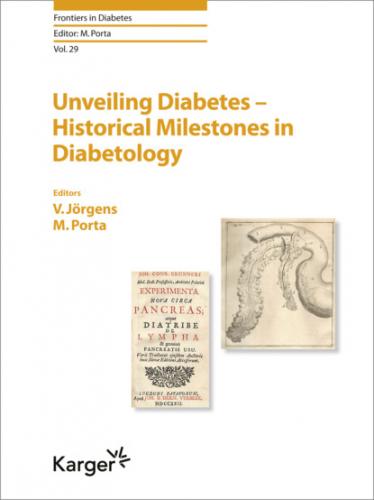12Gherli F: La scuola salernitana dilucidata. Venice, Corona, 1733.
13Platearius: Glossae in antidotarium Nicolai. Venice, 1571.
14Regimen sanitatis seu Flos medicinae scholae Salerni (transl. Sinno A). Salerno, EPT, 1941.
15Paré A: Opera Ambrosii Parei regis primarii et parisiensis chirurgi. Paris, Dupuys, 1582.
16Pissini S: De diabete dissertatio. Milan, Impressores Archiepiscopales, 1654.
17Willis T: Pharmaceutice rationalis, sive diabtriba de medicamentorum operationibus in humano corpore. London, JA Huguetan, 1676.
18Dobson M: Experiments and observations on the urine in diabetes. Med Obs Enquir 1776;5:298.
19Rollo J: Traité du diabète sucré, des affections gastriques et des maladies q’en dependent (French transl.). Paris, Moutardier-Cerioux, 1795 (An VI de la Révolution).
20Rollo J: Cases of the Diabetes Mellitus, with the Results of the Trials of Certain Acids, and other Substances, in the Cure of the Lues Venerea, ed 2. London, T. Giller for C. Dilly, 1798.
21Chevreul ME: Note sur le sucre de diabète. Ann Chim 1815;95:319.
22Fehling HC: Quantitative Bestimmung des Zuckers im Harn. Arch Physiol Heilk 1848;7:64.
23Bernard C: Leçons sur le diabète. Paris, Baillière, 1877.
24Brunner JC: Experimenta nova circa pancreas atque diatribe de lympha and genuino pancreatis uso. Lugduni Batavorum, Verbeek, 1722.
25Cawley T: A singular case of diabetes, consisting entirely in the quality of the urine; with an enquiry into the different theories of that disease. Lond Med J 1788;9:286.
26Bouchardat A: De la glycosuria ou diabète sucré; son traitment hygiénique. Paris, Germer-Baillière, 1875.
27Bouchardat A, Bouchardat G: Nouveau formulaire magistral. ed 27. Paris, Felix Alcan, 1888.
28Cantani A: Der Diabetes mellitus. Berlin, Hahn, 1880.
29Langerhans P: Beiträge zur mikroscopischen Anatomie der Bauchspeicheldrüse. Wilhelms-Universität zu Berlin, 1869.
30von Mering J, Minkowski O: Diabetes mellitus nach Pankreasextirpation. Zbl Klin Med 1889;10:394.
31Laguesse HGE: Sur la formation des îlots de Langerhans dans le pancréas. Paris, CR Soc Biol, 1893.
32Battistini F: Über zwei Fälle von Diabetes mellitus mit Pankreassaft behandelt. Ther Mhefte 1893;7:494.
33Zülzer GL: Über Acomatol, das deutsche Insulin. Med Kiln 1923;47:1551.
34Paulescu NC: Action de l’extrait pancréatique injecté dans le sang, chez un animal diabètique. CR Soc Biol 1921;85:555.
Prof. Massimo Porta, MD, PhD
Department of Medical Sciences, University of Turin
Corso AM Dogliotti 14
IT–10126 Turin (Italy)
Jörgens V, Porta M (eds): Unveiling Diabetes - Historical Milestones in Diabetology. Front Diabetes. Basel, Karger, 2020, vol 29, pp 14–24 (DOI: 10.1159/000506553)
______________________
Claude Bernard Invented Metabolic Research
Viktor Jörgens
Executive Director EASD/EFSD 1987–2015, Düsseldorf, Germany
______________________
Abstract
Claude Bernard invented metabolic research. He was born in 1813 in the small village of St. Julien en Beaujolais near Villefranche-sur-Saône. When he worked as an apprentice in a pharmacy in Lyon, he dreamt of becoming a writer, but finally started to study medicine in Paris. The beginning of his career was difficult, his salary as a researcher was miserable, and only an arranged marriage enabled him to dedicate his time to science. However, he was later appointed Professor at the Sorbonne and the Collège de France. His most important discovery was the unveiling of carbohydrate metabolism – he published this major discovery in 1848 “about the origin of sugar.” In 1855 he discovered and “baptized” glycogen. His book Introduction into Experimental Medicine (1865) was his intellectual masterpiece. Claude Bernard explained the principles of biomedical research, and much of the text is still relevant today. His remarks regarding pharmacotherapy can still serve as an introduction to today’s textbooks on “evidence-based medicine.”
© 2020 S. Karger AG, Basel
On July 12, 1813, in the castle of Trachenberg, Silesia, Tsar Alexander I of Russia, King Friedrich Wilhelm II of Prussia, and Bernadotte, later Karl XIV of Sweden, met and agreed on the “Trachenberg Plan” against Napoleon Bonaparte, an agreement that would eventually conclude with the “Battle of the Nations” in Leipzig, which ushered in the end of an era.
That same day, a man who started a new epoch in science was born. In the village of Saint-Julien near Villefranche-sur-Saône in the Beaujolais region, Pierre Jean-François Bernard appeared before the mayor and declared that between 3 and 4 o’clock in the morning of that day there was born to him, by his wife Jeanne Saulnier, an infant to whom he wanted to give the name Claude. He was their only son; a daughter was born later.
Claude Bernard grew up in a small old house which can today be visited by tourists (Fig. 1). The priest of the parish recommended the boy to be admitted to the Jesuit College of Villefranche, which he attended until the age of 18 years. Here he was taught Latin and French, but no other modern language. During his later life he always relied on the assistance of others to translate publications into French. He himself published
